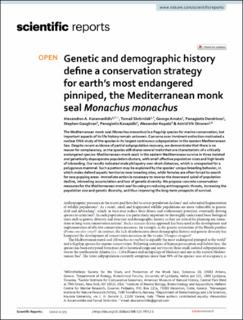| dc.contributor.author | Karamanlidis, Alexandros A. | |
| dc.contributor.author | Skrbinsek, Tomaz | |
| dc.contributor.author | Amato, George | |
| dc.contributor.author | Dendrinos, Panagiotis | |
| dc.contributor.author | Gaughran, Stephen | |
| dc.contributor.author | Kasapidis, Panagiotis | |
| dc.contributor.author | Kopatz, Alexander | |
| dc.contributor.author | Stronen, Astrid Vik | |
| dc.coverage.spatial | Eastern Mediterranean Sea | en_US |
| dc.date.accessioned | 2021-01-12T09:50:45Z | |
| dc.date.available | 2021-01-12T09:50:45Z | |
| dc.date.created | 2021-01-11T14:01:57Z | |
| dc.date.issued | 2021 | |
| dc.identifier.issn | 2045-2322 | |
| dc.identifier.uri | https://hdl.handle.net/11250/2722497 | |
| dc.description.abstract | The Mediterranean monk seal (Monachus monachus) is a flagship species for marine conservation, but important aspects of its life history remain unknown. Concerns over imminent extinction motivated a nuclear DNA study of the species in its largest continuous subpopulation in the eastern Mediterranean Sea. Despite recent evidence of partial subpopulation recovery, we demonstrate that there is no reason for complacency, as the species still shares several traits that are characteristic of a critically endangered species: Mediterranean monk seals in the eastern Mediterranean survive in three isolated and genetically depauperate population clusters, with small effective population sizes and high levels of inbreeding. Our results indicated male philopatry over short distances, which is unexpected for a polygynous mammal. Such a pattern may be explained by the species’ unique breeding behavior, in which males defend aquatic territories near breeding sites, while females are often forced to search for new pupping areas. Immediate action is necessary to reverse the downward spiral of population decline, inbreeding accumulation and loss of genetic diversity. We propose concrete conservation measures for the Mediterranean monk seal focusing on reducing anthropogenic threats, increasing the population size and genetic diversity, and thus improving the long-term prospects of survival. | en_US |
| dc.language.iso | eng | en_US |
| dc.rights | Navngivelse 4.0 Internasjonal | * |
| dc.rights.uri | http://creativecommons.org/licenses/by/4.0/deed.no | * |
| dc.title | Genetic and demographic history define a conservation strategy for earth’s most endangered pinniped, the Mediterranean monk seal Monachus monachus | en_US |
| dc.type | Peer reviewed | en_US |
| dc.type | Journal article | en_US |
| dc.description.version | publishedVersion | en_US |
| dc.rights.holder | © The Author(s) 2021 | en_US |
| dc.subject.nsi | VDP::Zoologiske og botaniske fag: 480 | en_US |
| dc.subject.nsi | VDP::Zoology and botany: 480 | en_US |
| dc.source.volume | 11 | en_US |
| dc.source.journal | Scientific Reports | en_US |
| dc.identifier.doi | 10.1038/s41598-020-79712-1 | |
| dc.identifier.cristin | 1869054 | |
| dc.relation.project | Andre: LIFE Nature projects LIFE05NAT/GR/000083 | en_US |
| dc.relation.project | Andre: LIFE Nature project: (LIFE12NAT/GR/000688) | en_US |
| dc.relation.project | Andre: Marine Mammal Commission of the USA | en_US |
| dc.source.articlenumber | 373 | en_US |
| cristin.ispublished | true | |
| cristin.fulltext | original | |
| cristin.qualitycode | 1 | |

